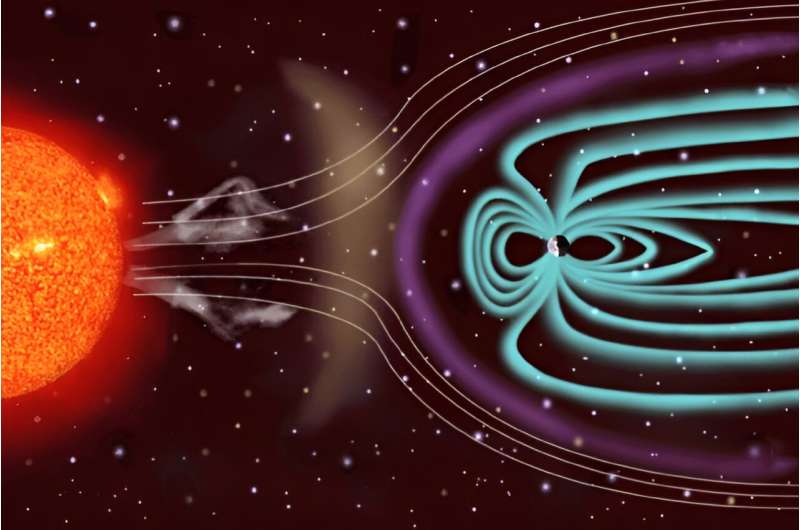This article has been reviewed according to Science X's editorial process and policies. Editors have highlighted the following attributes while ensuring the content's credibility:
fact-checked
trusted source
proofread
Parker makes its closest and fastest solar flyby

The Parker Solar Probe is the little engine that just keeps going and going by the sun. On September 27th, it made its 17th close approach and skimmed just 7.26 million kilometers (4.51 million miles) above the sun's "surface" layer (called the photosphere).
That's just the latest achievement by the probe, which also became the first-ever spacecraft to fly through a coronal mass ejection—and live to tell the story. That CME pass-through occurred on September 5, 2022, during its 13th approach to the sun.
The spacecraft's most recent accomplishment was set up by a gravity-assist flyby of Venus in late August. During the closest approach, the Parker Solar Probe was moving at 635,266 kilometers per hour (394,735 miles per hour). Both the close approach and the CME encounter are just two of many highlights of a mission that's planned to continue its studies of the sun and solar environment through mid-2025. So far, the spacecraft is in pretty good shape, considering what it's experiencing during the mission. Parker does all this while experiencing temperatures up to 1,400°C. Its main instruments are protected by shielding, which allows them to operate in a near-normal room-temperature environment.
Parker and its solar accomplishments
Solar scientists sent Parker to help them understand some of the most puzzling aspects of our star's activities. Its main target is the solar corona. They want to figure out what heats the corona by tracing the flow of energy that heats this uppermost part of the solar atmosphere. In addition, they want to understand how and why the solar wind gets accelerated as it leaves the sun.
Since the sun is largely plasma, they want to understand its structure and the magnetic fields that exist and influence the flow of plasma from the sun through the solar wind. Finally, the mission is equipped to study energetic particles flowing from the sun and determine their transport mechanism.
About that coronal mass ejection
We on Earth experience coronal mass ejections as they pass from the sun on their way through the solar system. These powerful events hurl huge masses of plasma through space, moving at speeds of 100 to 3,000 kilometers per second. Many CMEs do not encounter our planet, but when they do, they twist and stretch our planet's magnetic field. The results can range from beautiful displays of aurora borealis to disruption of communications and electrical grids.
Solar physicists would like to be able to forecast these awesome solar storms. They've long wanted to measure the forces that drive CMEs. In particular, they want to know what accelerates the charged particles in the explosions to high speeds. They hope that Parker can give them data on just what's happening on the sun as one builds up.
On September 5, 2022, Parker was cruising the far side of the sun. It flew just about 6 billion kilometers above the surface. That's when it detected the CME as it built up. Later on, the spacecraft passed through the structure of the ejection, experienced its leading edge, and then exited the material. It was a pretty extreme CME and allowed Parker to pick up data about the shock wave's speed and density. Luckily, this one didn't hit Earth. However, if it had, the event would have severely damaged communications systems and probably caused widespread power blackouts.
"This is the closest to the sun we've ever observed a CME," said Nour Raouafi, the Parker Solar Probe project scientist at the Johns Hopkins Applied Physics Laboratory (APL) in Laurel, Maryland, which built the spacecraft within NASA's timeline and budget, and currently manages and operates the mission. "We've never seen an event of this magnitude at this distance."
Parker and the sun
To get the scientific information to understand the corona and CMEs, scientists needed a spacecraft that could essentially fly through the sun—or at least its corona. That's where Parker comes into play. A heat shield, onboard radiators, and a thermal protection system protect it from CMEs and the solar wind. During the CME, the only effect it suffered was a little "torque"—a small turning action that it compensated for immediately.
For the rest of this year and into 2024, Parker will be following close orbits around the sun. In late 2024, it will make its final Venus flyby, which will set the last three perihelion passages into 2025. In all, scientists plan for 24 perihelion passages before the mission ends. The data it is providing should open new windows of understanding about the solar wind and the processes that launch it through the solar system.
Provided by Universe Today





















